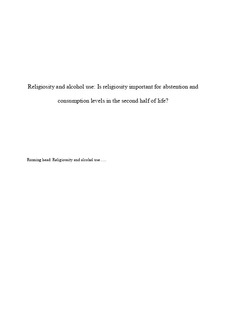| dc.contributor.author | Nordfjærn, Trond | |
| dc.date.accessioned | 2019-05-06T07:36:20Z | |
| dc.date.available | 2019-05-06T07:36:20Z | |
| dc.date.created | 2018-05-02T23:12:32Z | |
| dc.date.issued | 2018 | |
| dc.identifier.citation | Substance Use & Misuse. 2018, 53 (14), 2271-2280. | nb_NO |
| dc.identifier.issn | 1082-6084 | |
| dc.identifier.uri | http://hdl.handle.net/11250/2596531 | |
| dc.description.abstract | Objective: The aim of this study was to investigate the relative role of religiosity for alcohol abstention and consumption levels among individuals aged 40 years or above. Method: A two-wave prospective survey was conducted among Norwegians aged 40 to 80 years (Time 1 in 2002/2003, and Time 2 in 2007/2008). The analytical sample of the current study constituted those who responded to the questionnaire survey at both time points (n = 2671). Results: The findings showed that religiousity was strongly associated with abstention and less consumption while adjusting for demographics and health variables. The results also reflected that females and those with higher age were more likely to abstain from alcohol than males and those with lower age, respectively. Individuals with high education were less likely to abstain than those with basic education. Females and those with high age also reflected less alcohol consumption than males and individuals of lower age, respectively. Further, people who were married or with a registered partner consumed less alcohol than people who were not married or with a registered partner. High education and good physical health was associated with higher consumption. The main results were consistent across prospective and cross-sectional models. Conclusion: Religiosity seems to be important both for abstention and alcohol consumption levels in the second half of life. | nb_NO |
| dc.language.iso | eng | nb_NO |
| dc.publisher | Taylor & Francis | nb_NO |
| dc.title | Religiosity and alcohol use: Is religiosity important for abstention and consumption levels in the second half of life? | nb_NO |
| dc.type | Journal article | nb_NO |
| dc.type | Peer reviewed | nb_NO |
| dc.description.version | acceptedVersion | nb_NO |
| dc.source.pagenumber | 2271-2280 | nb_NO |
| dc.source.volume | 53 | nb_NO |
| dc.source.journal | Substance Use & Misuse | nb_NO |
| dc.source.issue | 14 | nb_NO |
| dc.identifier.doi | 10.1080/10826084.2018.1473431 | |
| dc.identifier.cristin | 1583028 | |
| dc.description.localcode | Locked until 29.6.2019 due to copyright restrictions. This is an [Accepted Manuscript] of an article published by Taylor & Francis in [Substance Use & Misuse] on [29 Jun 2018], available at https://doi.org/10.1080/10826084.2018.1473431 | nb_NO |
| cristin.unitcode | 194,67,40,0 | |
| cristin.unitname | Institutt for psykologi | |
| cristin.ispublished | true | |
| cristin.fulltext | original | |
| cristin.fulltext | postprint | |
| cristin.qualitycode | 1 | |
